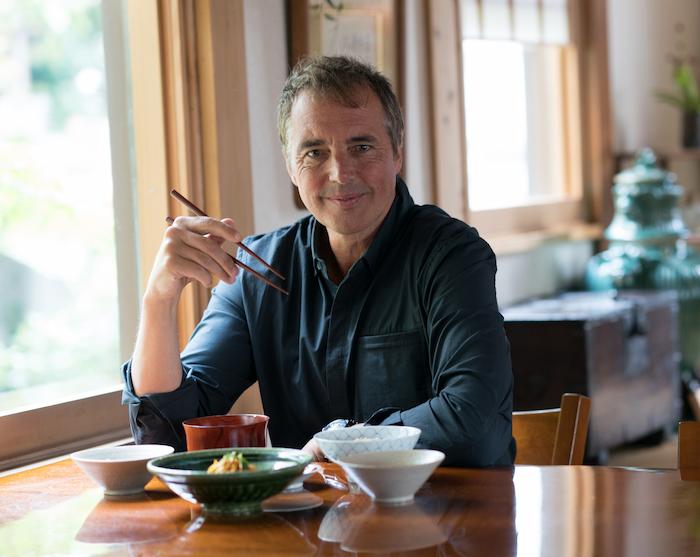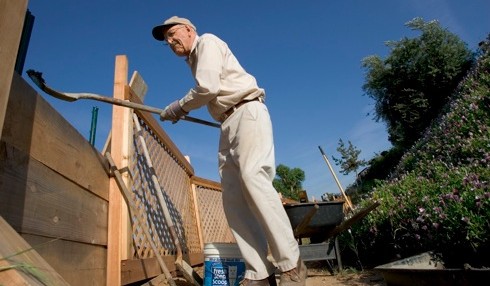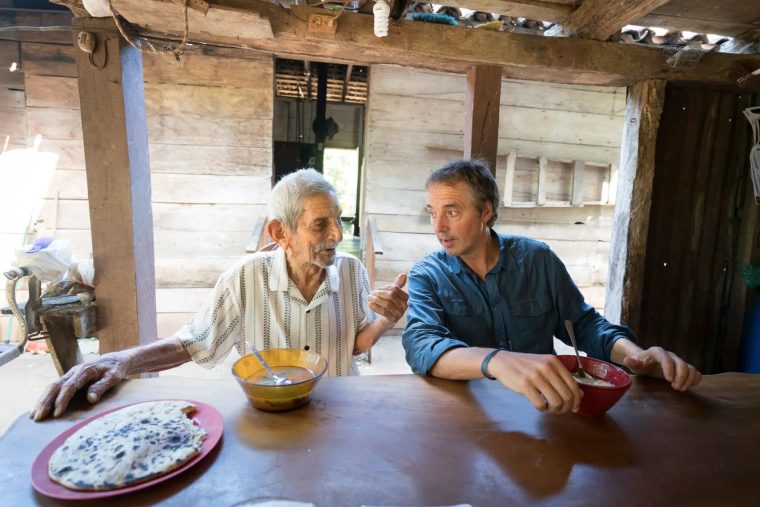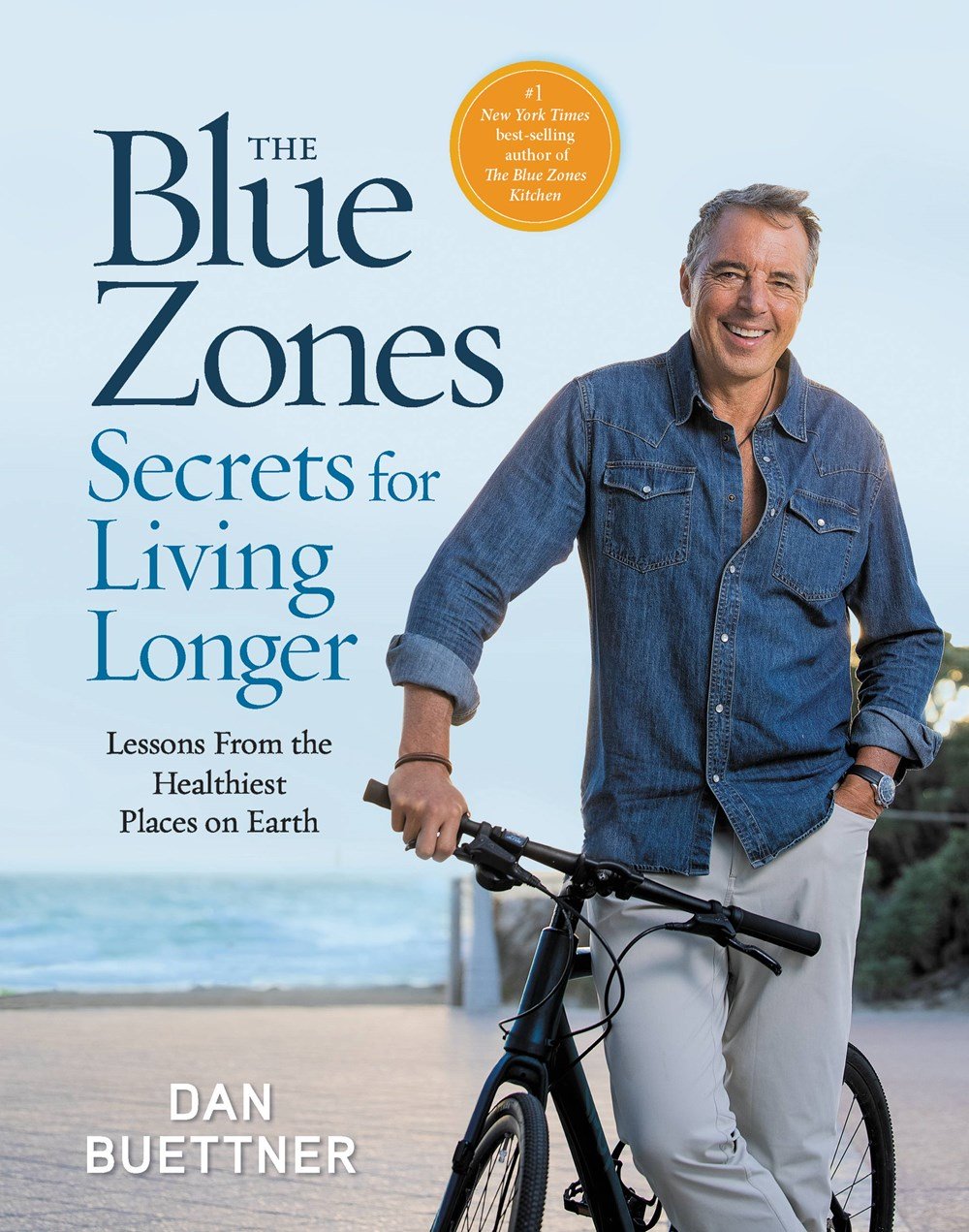Over the past couple of years, I’ve spent a lot of time on the road. I’ve traveled all around the country to research America’s forgotten diets for living to 100, and—even better—I’ve had the privilege to learn directly from the people who are revitalizing all of that wonderful, life-enhancing cuisine.
It’s been a trip, both literally and figuratively. All of those efforts just culminated in my latest book The Blue Zones American Kitchen, which came out only a couple of weeks ago. If you haven’t grabbed your copy yet, you can order it from any retailer where books are sold!
But I noticed something while I was criss-crossing the country, visiting with these wonderful people and learning about the food they knew best: I didn’t just feel like I was traveling between the places and peoples of America.
I felt, in the best of ways, like I was traveling back in time.
At a high level, yes, The Blue Zones American Kitchen shows us a way of eating that we collectively haven’t seen for a long time, and that’s much of the point. But some of the smallest details of my experience on the road—for example, cooking outside over an open fire—got me thinking in new ways about the education I try to provide through my work…
… and when you’ve got hundreds of miles in front of you, some of that thinking can gel together better than usual. In fact, between the open fire and the open road, I found a new way of thinking about a key nutritional topic that I (intentionally) revisit a lot.
So here goes—and if you think you’ve already read what I’m saying next, just keep going and you’ll be in new territory soon.

I can’t tell you how many times I’ve shared (some form of) this information:
Complex carbs like whole grains are good for you; in fact, the world’s longest-lived people tend to eat diets which are mostly complex carbs. On the other hand, processed (AKA ‘refined’ or ‘simple’) carbs like the white flour and sugar in Twinkies are among the deadliest killers in the developed world.
I’ve repeated it so many times, and in so many minor variations (including the paragraph above), because the distinction is that important. People need to know that the difference between complex carbs and simple carbs is, pretty literally, the difference between long life and early death. Failure to heed that distinction has already created generations’ worth of serious problems for us…
… and yet, the public still doesn’t seem to “get it.”
There’s something about the Simple vs. Complex Carbs spiel that isn’t sticking, clicking, or fully computing for people. The core information is simple enough, but there’s a difference between comprehension and understanding; people can look at the stars all night and never see the constellations (figuratively speaking). So I’ve wondered…
What’s missing from the usual info?
What details might help people understand better?
Which dots aren’t being connected?
I realized recently that one of the biggest gaps in public knowledge has been hiding right under our noses. Ironically, too, it’s the only thing that simple and complex carbs have in common: the ‘carbohydrate’ part.
I can list differences between simple and complex carbs until I’m blue in the face, but if someone doesn’t know what carbohydrates ARE, it’ll be much harder for them to understand those differences with any real clarity or nuance. It’s worth taking another look at the main role of (all) carbohydrates in our diet so we can better understand why one type of carb extends life and another cuts it short.
This won’t resemble a typical biology or chemistry lecture; if anything, I’ll have to ask the scientists’ forgiveness for my generalizations, simplifications, and analogies. ?
Let’s start with the broadest concepts and work our way in:
General Idea #1: All (active) energy comes from burning things. “Burning things” is shorthand for “converting potential (stored) energy into kinetic (active) energy,” but the ‘burning’ part isn’t as figurative as you might think. Whether you’re talking about a campfire, a gas-powered engine, or the human body, you’re talking about a system whose energy-releasing reactions (A) require a continuous supply of oxygen and (B) produce heat as a byproduct.
General Idea #2: Carbohydrates provide our bodies with burnable energy. Continuing the above, it’s not much of a stretch to say that the human body is warm-blooded (internally 98.6F, yet most comfortable in ~72F air) because there are billions of tiny little fires burning in our cells at any given moment. Those little fires get oxygen by way of our lungs and red blood cells, and most of their burnable fuel comes from carbs.
Remind me: what’s the difference between carbs and calories? Basically, carbs are the firewood and calories are the fire. To be more specific: a “carb” is a burnable substance whose molecules contain a particular ratio of carbon, hydrogen, and oxygen—hence the name carbohydrate—and a “food calorie” (scientifically a kilocalorie) is the amount of energy you need to raise the temperature of 1 kilogram of water by 1 degree Celsius.
General Idea #3: Virtually all fuels (including food) have to be processed before they can be burned in useful ways. Make no mistake, I am still against “processed foods” in the dietary context that we inhabit nowadays—but removed from context, the word processing might be even broader than carbohydrate. “Food processing” is how we get cheese in a can, yet it’s also how we get pre-washed organic produce in compostable packaging. ?
In any case, when we consider the full range of “processing,” we realize that virtually any fuel has to be processed before it can be burned for a specific purpose. Even if firewood is just “raw tree” with no added ingredients (not even salt!), the tree still has to be chopped into manageable pieces before you can use it as firewood per se. In a similar vein: even if you’re eating pure, whole foods straight out of nature, you still have to chew them and digest them before they can give your body energy.
General Idea #4: The more a fuel source is processed, the more volatile the fuel becomes. Energy sources tend to become more volatile the more they’re processed because, as vague as the term may be, all “processing” tends to alter the fuel source’s energy in one (or more) of the following ways:
- Condense and/or Purify It — In other words, the processing consolidates the bits of “pure burnable energy” closer together. It breaks complex things down into simpler parts and, in many cases, gets rid of the stuff that doesn’t burn as well (refinement).
- Fortify It — In other words, the processing adds stuff that wasn’t there before. It could be more of the same (“sugar on top”), it could be a catalyst that enhances certain reactions, it could be a preservative or a thousand other things… but the point is that processing can add things to fuel to improve its function or longevity in some way.
- Optimize It for Reaction — In this case (unlike the above two), you’re not changing the composition of the fuel; rather, you’re changing the format of the fuel so that its existing energy can be released faster and/or more evenly. A common example for chemical reactions is increasing the surface area of the reactants, often by breaking solids into smaller pieces.
We chew our food and mix it with saliva before swallowing for the latter reason; the energy is far more accessible to our stomachs that way. As mentioned above, it’s also how a burnable tree becomes manageable pieces of firewood and kindling.
Firewood is one of the least volatile fuels I can think of, but to further illustrate General Idea #4 (and to illustrate just how far science has extended “processing”), let’s consider the other burnable fuels we could theoretically make from the exact same tree. I can think of four: charcoal, paper, methanol, and gasoline.
Notice that, compared to firewood, they require progressively more processing; you only need fire and dirt to make charcoal, but you need scientific equipment to make methanol and gasoline. In exchange, the fuel becomes progressively more volatile; firewood burns, charcoal burns hotter, paper burns faster, methanol burns hotter and faster, and gasoline explodes.
The whole idea of “processing” or “refining” energy sources (like trees, per the above) also applies to the carbohydrates in our food…
… and so we return to the differences between simple and complex carbs. But we return to that question a little bit wiser because, having explained the basics of what simple and complex carbs have in common (the ‘carbohydrate’ part), I can tell you exactly where they diverge:
Simple and complex carbs both “burn,” but they burn in very different ways. Complex carbs burn more like firewood; simple carbs burn more like newspaper.
That’s the main idea I wanted to impart for today, and I hope it lights a fire in your brain. ?
Still, since I keep saying that simple carbs are bad and complex carbs are good, I’ll extend the campfire analogy juuuuuuust far enough to start showing you why.
In two quick parts:
Part I ? The human body was “built” to burn firewood AKA complex carbs, and not newspaper AKA simple carbs, because the former have always been plentiful in nature. Newspaper (and its dietary equivalent, refined sugar) didn’t really exist until a few hundred years ago, which is a fraction of a second in the grand scheme of our evolutionary history.
Having said that…
Part II ? Picture a campfire—and I mean a ghost-story-telling, marshmallow-roasting, warm-until-morning kind of campfire. Try and remember the intensity of the heat, the way it can bake you from a distance.
Now imagine trying to re-create that experience using only newspaper, without a stick of firewood in sight.
It would be a total disaster, right? Little bits of flaming paper would be swirling around the campsite; the campfire itself would be a cold, emberless flame barely useful for anything; not least of all, the fire would quickly be smothered by its own ashes.
Well, that’s basically what’s happening on the inside of your body’s cells when you eat a diet of highly-processed junk food. It’s a messy situation… and this analogy only scratches the surface of the problems at hand.
I’ll explain more about (simple and complex) carbohydrates in future editions of Eating to 100, and I’ll return to the campfire analogy wherever it helps. For now, just remember that the best foods and the best foods for thought are like firewood: they might need a little longer to get burning, but they’ll do a much better job of keeping you warm and informed over the long haul.
Now then! Speaking of burning trees and unprocessed foods, let’s move on to some tastier stuff…

Herbs have been shown to have an endless array of health-boosting benefits—including supporting a healthy immune system, fighting free-radicals and inflammation in the body, and even staving off chronic diseases such as cancer—which means they are naturally correlated with increased longevity. And when you take a look at the pantries of centenarians in the blue zones, it makes sense, as herbs and spices are a mainstay in each of these regions’ meals (beverages included).
They pack antimicrobial and antioxidant properties that boost heart health, immunity, and healing, plus they add flavor to food without any nutritional drawbacks.
These are the five herbs that centenarians will recommend you keep on hand (fresh if you can). Incorporating them into your cooking on the regular will give you a heart-healthy, antioxidant-rich boost linked to longevity.
And in the shorter term, they’re guaranteed to make whatever you’re eating taste better, too.
Fennel
Fennel can be used three different ways: the bulb is used as a vegetable, the fronds as an herb, and the seeds as a spice. Talk about an overachiever. Both the bulb and seeds of the fennel plant contain the mineral manganese, too, which is important for enzyme activation, cellular protection, bone development, blood sugar regulation, and wound healing. Fennel also offers other minerals that are important for bone health (such as potassium, magnesium, and calcium) and has dozens of plant compounds that act as a potent antioxidant and anti-inflammatory agent.
Rosemary
Rosemary not only tastes delicious in a wide array of dishes, but it is also a great source of iron, calcium, and vitamin B6. The herb has also been shown to boost cognitive health, increase memory retention, and help your immune system function at its best. This is because rosemary contains an ingredient called carnosic acid, which can fight off damage by free radicals in the brain, but it’s also due to its delicious (and potent) aroma. According to research outlined in Therapeutic Advances in Psychopharmacology, the scent of rosemary has the potential to improve your concentration, performance, speed, and accuracy and, to a lesser extent, your mood.
Cilantro
Cilantro packs plenty of antioxidants, and has been shown to fight inflammation and lower your risk of certain chronic illnesses, particularly heart disease. A mouse study also found that cilantro leaves improved memory, suggesting that the plant may have applications for Alzheimer’s disease, but more research is needed.
Oregano
The antioxidants in oregano can help prevent cellular damage by neutralizing disease-causing free radicals in the body and reducing inflammation. And on the antibacterial front, one study actually found that oregano was effective against 23 species of bacteria. In addition to offering its own array of health benefits, oregano will boost the flavor of other nutrient-packed dishes, making plant-based foods like veggies and beans even more inviting.
Garlic
What’s not to love about garlic? For centuries, garlic has been known to have medicinal properties, which make sense since it’s a staple in all of the Blue Zones regions, particularly Okinawa, Japan. While it isn’t technically an herb—garlic is a plant in the Allium (onion) family—it is used as a similar health-boosting flavoring agent in cooking.

The Blue Zones American Kitchen is available now! If you haven’t ordered your copy yet, you can do so from any retailer where books are sold. Each week, we’re celebrating some of the incredible chefs who have shared their brilliance with us in this lost American Diet of Longevity.

Nico Albert of the Cherokee Nation is a self-taught chef, caterer, and student of Indigenous cuisine. After growing up in California and Arizona, she returned to Tulsa, Oklahoma, the land of her mother’s people, to re-establish a relationship with her Cherokee community and begin her work to improve the health and wellness of Native Americans.
Nico is the owner of Burning Cedar Indigenous Foods—a catering, educational, and consulting service specializing in Native cuisine—and she was kind enough to share her recipes for Creamy Squash Soup and Fire-Roasted Cabbage with Roasted Chili-Chestnut Sauce in The Blue Zones American Kitchen.

Creamy Squash Soup With Corn Salsa and Wild Onion Chimichurri

Ingredients
For the Chimichurri:
12 wild onions or 4 to 5 green onions, trimmed
1⁄4 cup chopped parsley leaves (stems removed)
1⁄4 cup apple cider vinegar
1 tablespoon pure maple syrup
2 teaspoons salt
1⁄4 cup sunflower oil
For the Soup and Salsa:
6 ears sweet corn, shucked
2 tablespoons sunflower oil
1 large yellow onion, diced
4 large garlic cloves, minced
6 cups water
2 pounds winter squash, peeled, seeded, and cut into 2-inch cubes
Salt
Freshly ground black pepper
2 small jalapeño peppers, seeded and very finely diced
The Method
To make the chimichurri, on a grill or in a very hot, dry cast-iron skillet over high heat, cook the wild onions until nicely charred in some spots but not totally blackened.
Coarsely chop the charred onions and add them to a blender or food processor with the parsley, vinegar, maple syrup, salt, and oil.
Puree the mixture until it reaches a slightly chunky, pesto-like consistency. To make the soup, cook the ears of corn on a grill, turning occasionally, until they are lightly charred on all sides. Remove the corn from the heat and set it aside to cool.
Add the oil to a large (5- to 7-quart) Dutch oven or stockpot and heat over medium heat.
Add the yellow onion and garlic. Cook, stirring frequently, until the onion and garlic have caramelized and turned a light golden brown. Cut the corn from the cobs, reserving the cobs for the soup and the kernels for the salsa.
Put the cobs in the pot with the sauteed onion and garlic. Add the water to the pot, place it over high heat, and bring it to a boil. Reduce the heat to a simmer (if cooking over a fire, move the pot to a cooler spot on the grill to maintain a simmer).
Allow the mixture to simmer for 15 to 20 minutes, until the broth becomes fragrant with the aroma of sweet corn and the liquid has reduced to about 4 cups.
Add the cubed squash, bring the liquid back to a simmer, and cook until the squash is very tender. Working in batches, use an immersion blender or a countertop blender (allow to cool slightly before putting into blender) to puree the soup until smooth. Season with salt and black pepper to taste.
To make the salsa, combine the reserved corn kernels with the jalapeño and stir to mix well. Season with salt and pepper to taste. To serve, ladle the soup into bowls, garnish with a generous scoop of the roasted corn salsa, and drizzle with the wild onion chimichurri.





